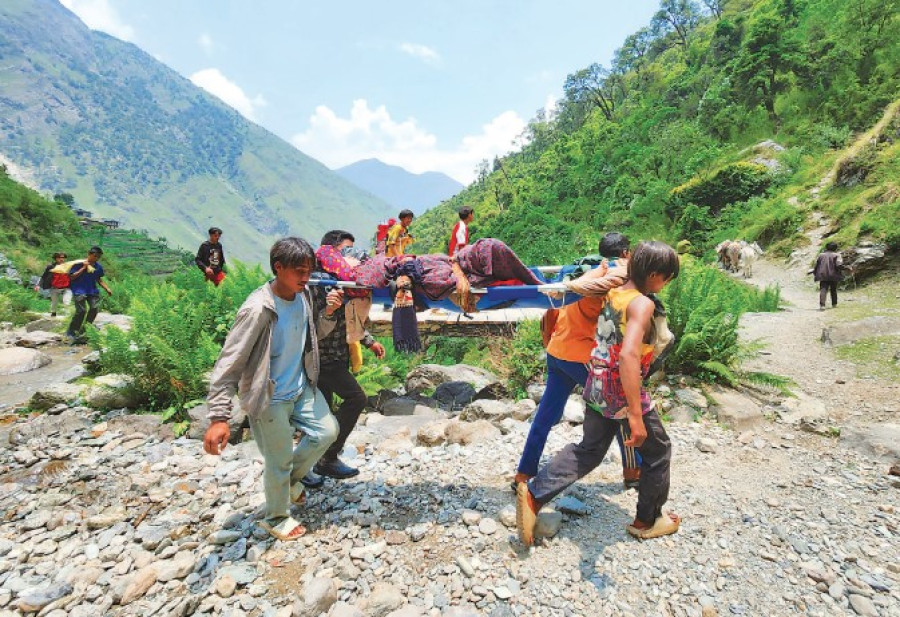Special Supplement
Nepal’s health sector under the budget knife
Experts warn budget cuts could undo the progress the country has made in the health sector over the past several years.
Arjun Poudel
Investing in health systems is like buying an insurance policy.
The Covid pandemic has taught Nepal a valuable lesson—and experts have warned that failure to invest in health systems, will put everything—people and the economy—at risk in the long run.
Globally, countries that have invested in their health systems were better equipped to respond to Covid shocks. But those that did not, found themselves facing a full-blown crisis.
Health is a driver of economic growth in various ways. Healthier populations are happier, more productive, and play an active role in the workforce.
However, due to political and economic uncertainty, Nepal’s finance ministry has been struggling to maintain a balance between income and expenditure. As a result, the apparent remedy appears to be to cut the health budget.
The health sector has been facing budget cuts for the last two years. And the upcoming budget, too, does not look promising for the health sector.
Nepal has been gambling with the health sector budget, putting the lives and wellbeing of millions at stake.
Until last fiscal year, hospitals were implementing safe motherhood programmes, which they provided free of cost. Hospitals, however, have not been reimbursed for those services in the current fiscal year.
The upcoming budget may give priority to this programme again, but the government may, as usual, delay its reimbursement.
The Health Ministry has signed agreements with 118 state-run and community hospitals to provide safe motherhood programmes free of cost. The programme is credited with reducing home deliveries and newborn deaths.
More than 200 birthing centres across the country lack skilled birth attendants as the government didn’t allocate a budget to retain nurses.
Nepal had reduced the maternal mortality rate from 539 per 100,000 births in 1996 to 239 per 100,000 births in 2016—for which the country even received a Millennium Development Goals award.
A report by the National Statistics Office, formerly the Central Bureau of Statistics, showed that out of every 100,000 live births, 151 women die from maternity-related complications.
The institutional delivery rate reached around 80 percent, from just 18 percent in 2009. The government launched free institutional delivery services in 2009.
The ongoing fiscal year, ending mid-July 2024, saw the government slash more than 35 percent of the budget in the health sector, after a 20 percent cut in the previous fiscal year, except the budget allocated for Covid vaccines.
Already, the health budget has seen over 50 percent cut in the last two years, citing a plunge in revenue collection.
Officials said that they have been instructed to prepare a budget for the next fiscal year within the ceiling of the current fiscal year. The reduction in the national health budget, experts say, would lead to cuts in programmes.
“Due to a massive cut in the health sector budget, we have been unable to allocate sufficient funds to hospitals,” said Dr Bibek Kumar Lal, director of the Family Welfare Division, under the Department of Health Services. “Budget cuts have affected several healthcare programmes.”
Public health experts warn of serious repercussions from the massive annual cuts in the health budget, saying this will directly affect the country’s priority programmes like maternal health, child health immunization and nutrition, as well as the management of serious transmittable diseases like HIV and tuberculosis.
Experts have warned that the reduction in the budget could jeopardise achievements made in the health sector over the past several years.
The government needs to increase the budget for routine vaccines by 15 percent annually, which will require funding in millions to ensure the availability of free routine vaccines.
The Health Ministry provides 13 types of childhood vaccines free of cost under the routine immunisation programme.
Due to a lack of sufficient budget, health facilities have been unable to procure contraceptives such as condoms, pills, implants and emergency pills.
Due to inadequate funding, from this fiscal year, health authorities have been unable to expand verbal autopsy, a method of determining the cause of maternal death when no medical record or formal autopsy is available.
In Nepal, this method is being used to determine the causes of maternal deaths in 42 of the 77 districts.
Similarly, funding cuts for mosquito nets and malaria testing kits have already affected the malaria elimination programme.
According to health officials, there was a plan to procure 180,000 lasting insecticide-treated bed nets for the ongoing fiscal year, but only 120,000 nets could be purchased.
Also, the Epidemiology and Disease Control Division had planned to buy 500,000 malaria testing rapid diagnostic kits for the ongoing fiscal year, but it was able to purchase only 315,000 pieces.
The budget has also affected the health awareness drive, which is very crucial to reducing the burden of diseases.
“It's a pity. The budget cuts for key programmes of maternal health, which have played an important role in reducing maternal deaths, are concerning,” said Dr Ganesh Dangal, chairman of the Nepal Society of Obstetricians and Gynecologists.
“This is not the appropriate time to cut the healthcare budget.”
The Nutrition Section of the Family Welfare Division under the Department of Health Services had planned to expand Outpatient Therapeutic Care (OTC) to all health posts throughout the country in the ongoing fiscal year 2023-24. While around 3,800 health posts are operating throughout the country, only 1,000 of them are currently providing OTC services.
This involves the management of non-complicated cases of severe acute malnutrition in outpatient care using ready-to-use therapeutic foods.
“Providing services to severely malnourished children is crucial. It reduces the existing burden of malnutrition in Nepal,” said Lila Bikram Thapa, chief of the Nutrition Section.
Malnutrition is considered a silent health crisis in Nepal. The country has made significant progress in reducing stunting among children under five. Stunting decreased from 57 percent in 2001 to 25 percent in 2022, according to the Nepal Demographic and Health Survey-2022 report.
Wasting, a debilitating disease that causes muscle and fat tissues to waste away, among children under five, decreased from 11 percent in 2001 to eight percent in 2022.
Wasting or low weight for one’s height in children, if not treated properly and on time, is associated with a higher mortality risk, according to the World Health Organisation.
Experts say malnutrition affects children’s mental growth, too, which in turn undermines the country’s economic health. It weakens intellectual capacity, limits productivity in adulthood, and increases vulnerability to certain diseases.
Along with a halt in the extension of the OTC services, several other programmes of nutrition—expansion of nutrition rehab centres, and purchase of equipment to measure the height and weight of the children—have also been affected due to budget cuts, officials said.
The free treatment for women suffering from cervical and breast cancers has also been impacted by the budget cut.
“Reducing the budget in health care every year, which had not happened since the start of the public health programmes, will have serious consequences,” warned Dr Baburam Marasini, a former director of the Epidemiology and Disease Control Division.
“We risk losing several achievements made through years of investments and efforts. What will happen if a polio case is detected in the country? It will trigger an international emergency. ”




 12.12°C Kathmandu
12.12°C Kathmandu










